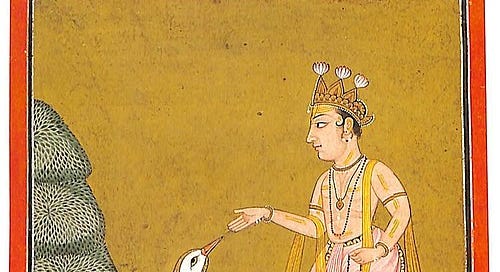Raag Hamsadhwani - part deux exploring romance as a theme
This one is very special. I get to nerd out with my inspiration over a music piece. An exclusive recording of a hamsadhwani bandish being taught to a fairly musical audience, which now includes you.
Attending the Exploratorium’s “the great animal orchestra” made me appreciate my many mornings in the forests of Karnataka, listening to the million birds drowning out the silence. Very few understand when I say, I miss the barbets calling every morning in Uru, at least when I visit. Imagine my surprise when I heard a famous bard graced my hometown, set an example in progressive art, and created a legacy still being discussed by scholars.
It started as an average Tuesday night at home, but a YouTube video caught my attention. A venue caught my attention, Fort Chamarjpet. It’s a concert in my hometown of Bengaluru in 1956, by Bade Ghulam Ali Khan sahib 😁
I dug further and realized that one of my inspirations to study history, Prof. R. Guha, has written about this exact concert. He stood at the same crossroads I did and wondered the same thing. What a different time and era.
And I quote.
Digging deeper on You Tube, I discovered, to my great delight, that this particular rendition of Hamsadhvani was from a concert that Bade Ghulam Ali Khan had given in my home town, Bangalore, in 1956. The concert was part of the Rama Navami festival, then (as now) an important part of the city’s musical calendar, and held always in the capacious grounds of the Fort High School in Chamarajpet.
The ‘Fort’ after which this High School is named was originally a mud structure, built by Kempegowda in the 16th century. It was later rebuilt in stone by Hyder Ali, and further embellished by Hyder‘s son Tipu in the 18th century. However, the school itself dates to the early 20th century, and its building, a very handsome one, is constructed in the British colonial style.
These further details enchanted me. For, in recent years, I have sometimes attended concerts at the Rama Navami festival myself. I was not born in 1956; but it is entirely likely that among those who hear Bade Ghulam sing there that year were people I was to later come to know, such the celebrated Bangalore rasikas Shivaram and Lalitha Ubhayaker. I like to think (or hope) that also in the audience that day was the legendary physicist C. V. Raman, who had a keen interest in classical music. Perhaps some uncles and aunts of mine who lived in Chamarajpet were in attendance too.
So here was Bade Ghulam Ali Khan, singing Hamsadhvani at the Ram Navami festival, held annually at the Fort High School in Bangalore. A Muslim musician in India, born in what is now Pakistan. An acclaimed ustad of a gharana of Hindustani music patronized by Sikh Maharajas. Singing a raga of the Carnatic style, in a festival named after the greatest of Hindu deities, held in the grounds of a school built in British times but named after a fort that dated to the 16th century and whose present form owed itself to both Hindu and Muslim rulers.
Full article - Originally published in the Telegraph
On to a new song
This recording of a teaching session is ceremoniously held at the end of every Bayraagis music session. Thanks to Madhurranjan for always leading and creating a culture of teaching around music. I was surprised to hear how musically trained the audience was during one of our Bayraagis sessions in San Jose. If you’re local to the Bay Area, I highly recommend attending one of our events. It’s an electric atmosphere.
First, here’s the bandish.
Keep reading with a 7-day free trial
Subscribe to Classicalweekly.org to keep reading this post and get 7 days of free access to the full post archives.



